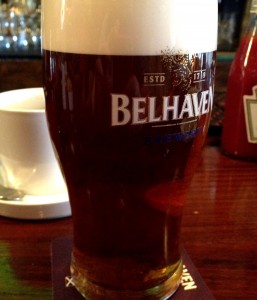
A Beautiful Pint of Scottish Ale
Is it a desire to flaunt the bountiful fields of barley found in Scotland or is it simply a desire to warm one’s bones and soul from the cold northern winds? Regardless of the answer it is certain that the traditional Ales of Scotland are rich with sweet and unctuous malted barley and deeply satisfying. Beer has been produced in Scotland for about 5,000 years so they know a little about the subject. Despite the Scots wonderful compulsion to distill their fermented malt beverage they fortunately do reserve some of the malt for the tap.
While variations certainly do exist, the classic Scottish style is brilliant amber to the eye with a sweet, roasted malted barley aromatic profile and silky, caramel malt-driven palate. These Scottish style Ales are far more mild and subtle in their use of hops than their English counterparts.
Scottish style Ales can be found in far-flung corners of the world where faithful versions are brewed, this being a legacy of its popularity in the UK. In the US many craft brewers produce a Scottish style Ale. Some versions are made in the New World, utilizing smoked malt to mimic the smoky style of single malt Whiskies like those hailing from Islay. Some brewers outside of Scotland are occasionally overcome by the desire to add heaping quantities of hops to match the heavy malt component. We are not great fans of the heavy-handed hopping of Ales under the Scottish Ale flag.
Variations Of Scottish Ale
Classically, Scottish Ales were sold and identified by strength. The styles ranged from (not at all like a modern light Beer purchased at the ballgame), Heavy, Export, and Wee Heavy. In the 19th century it was popular to identify these grades by the schilling price per barrel. These expressions did range from 60 schilling for the light to 90 shilling for the Wee Heavy. With the revival of true Cask Ales and microbreweries, the schilling moniker has made a bit of comeback.
When, Where, and How to Enjoy Scottish Ale
Scottish Ales are typically served in a classic British pint glass. Those sub-styles that travel to the Wee Heavy or beyond can be served in a small goblet as a pint or two of such an Ale can take you on an unexpected adventure.
The Light or Heavy styles are often good session Beers and are a great choice regardless of what the calendar may say. We like these Beers as an accompaniment to Scotch Whisky. Two utilizations of Scottish malted barley side-by-side is a hard combo to beat. These Ales are also great with fish & chips or other pub favorites.
The Export and Wee Heavy styles are great winter warmers. Sitting by the fire with a hearty stew or perhaps some Stilton would be a fine way to conquer the chill and persistent lack of sunlight (a wee dram of Scotch Whisky wouldn’t hurt).

I like Scottish Ales. Your description is really helpful vocabulary. Mostly I get them when I’m out with my sister in her city in the Midwest. I’ll have to look for a good place for them in NYC. Harlem does not seem a good center for those beers.